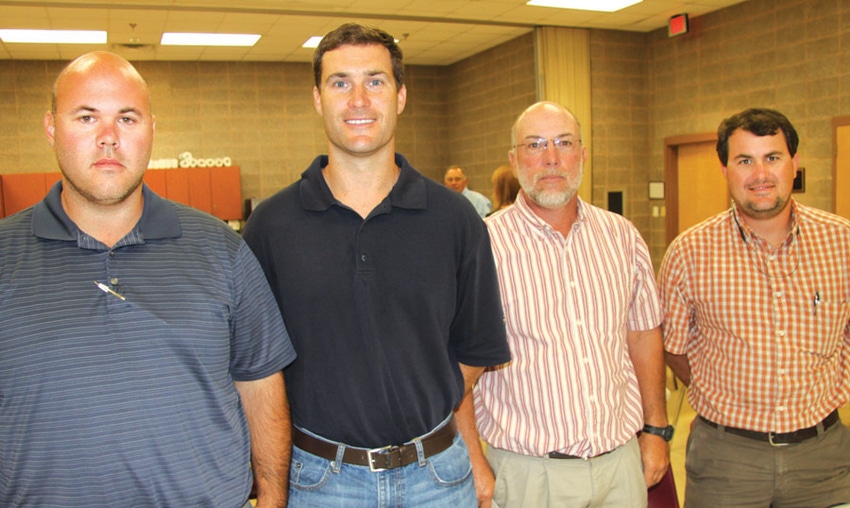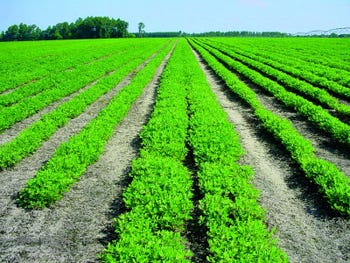
Mississippi peanuts feeling effects of abnormally hot, dry weather
“I’ve covered most of the state’s peanut-growing areas the last few days, and with the very hot, dry weather, crop growth has slowed considerably, says Mike Howell, Mississippi Extension peanut specialist. He discussed the situation at the Mississippi Farm Bureau Federation’s summer peanut commodity meeting at Grenada.

The blazing hot, and mostly dry, weather that kicked off July has slowed growth of peanuts over much of Mississippi, says Mike Howell, the state’s Extension peanut specialist based at Poplarville.
“I’ve covered most of the state’s peanut-growing areas the last few days,” he said at the Mississippi Farm Bureau Federation’s summer peanut commodity meeting at Grenada, “and crop growth has slowed considerably. Some who have irrigation capability have already been watering their peanuts.”
Marshall Lamb, director of the USDA’s Agricultural Research Service National Peanut Research Laboratory at Dawson, Ga., who also spoke at the meeting, said the hot, dry weather, going into July, was endemic across the Southeast.
“Sixty percent of the peanut acres in the Southeast are extra dry right now, with no sign of moisture in the forecast,” he said. “One bit of good news is that, after 23 months with no rain in the Texas peanut production areas, they’ve had rain and are in somewhat better shape — but the rain didn’t help replenish the aquifer, and moisture will continue to be critical there.”
The weed situation in Mississippi peanut fields varies, Howell said. “The farther north, the better the weed situation looks. Down toward the gulf coast, we had some major problems trying to keep weeds under control, and some growers are still having issues.
“It’s getting somewhat late to be coming in with herbicides, unless you have a really bad problem. Some growers have been talking about making applications of Cobra, Blazer, or other materials, but once peanuts start blooming and going into the reproductive mode, we need to try and stay away from these applications unless there’s really a major problem.”
A few foliage-feeding caterpillars could be found in alm,ost any field at the end of June, Howell said, “But they’ve all been well under threshold levels.
“The most I’ve seen was three to four worms per row foot, and our threshold is six per row foot. A few growers have made applications for this pest, but be sure you’re at threshold level before you start spraying. With these very hot, dry conditions, we don’t want to do anything that would flare spider mites or other insects.”
There has been, he said, “a lot of talk about diseases, but on my travels around the state I’ve seen essentially no problems warranting treatment. A lot of what growers have been seeing and calling leaf spot is actually chemical burn from some of the herbicide applications earlier in the season.”
On the day of the peanut meeting, Howell said, “My phone started ringing about 6:15 this morning that somebody had reported finding white mold yesterday in a field at Clarksdale. And now, it has spread like wildfire that white mold is taking over the Delta and everybody needs to spray everything in the Delta to control white mold.
“Don’t get alarmed by reports like this, and don’t jump the gun just because you hear something — check it out before you do anything. White mold is going to be around, and it’s about time to start thinking about applications, but don’t base what you do on rumors. If your peanuts are about 60 days old, that’s when you normally need to begin making applications for white mold.
“But, with the products we use to control this disease, you really need to get a rain to wash the material into the soil. With the forecast for 100-degrees plus and a bare minimum chance of rain, I would lean toward holding up on white mold applications to see if you can get a better chance of rain so you can get the most good from these products.
Moisture needed for disease establishment
“Disease needs moisture to aid establishment, and as hot and dry as it is, it’s going to be hard for any disease to get established. I’ve been in the field two days this week, and even before 7 o’clock in the morning I didn’t get my boots wet — there’s not even any dew.
“So, let’s not get in too big a hurry to make disease control applications.”
Growers who haven’t already done so should be applying their first shot of boron, Howell said.
“You can put out a half-pound in one application, or split it into two applications — it really doesn’t matter, as long as you get the boron on in a timely fashion, about the time peanuts start blooming.”
With the large increase in peanut acreage in Mississippi this year, he said, research projects and field trials have been expanded.
“We’ve got a big peanut location at the White Sands Experiment Station near Poplarville, including fungicide and insecticide efficacy trials, seeding rate studies, several variety trials, thrips control studies, a tillage study, and inoculation trials.
“We’re going to have a lot of things to show you at our field day there Aug. 30 at 9:30 a.m.. There should be a lot of good information at this event, so please make plans to attend. We’re also going to try to bring in experts from other areas.
“Dr. Charles Chen, associate professor at Auburn University who is associated with the National Peanut Laboratory at Dawson, Ga., has some advanced breeding lines at the station, a couple hundred different plots looking at new varieties. We hope to have him at the field day.
“Dr. Jeff Gore, assistant research professor at Stoneville, has several insect control trials at the Delta Research and Extension Center, and Dr. Alan Henn, Mississippi State University professor of entomology and plant pathology, has white mold trials in several locations.
“We’ve got a lot of peanut research going on this year, which is indicative of the importance this crop is now getting in Mississippi.”
About the Author(s)
You May Also Like



